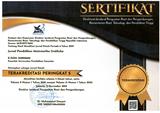PENGARUH MODEL PEMBELAJARAN CLIS TERHADAP KEMAMPUAN PENALARAN MATEMATIKA SISWA KELAS VII SMP NEGERI 6 SINGARAJA
DOI:
https://doi.org/10.23887/jjpm.v3i1.5580Abstract
Tujuan penelitian ini adalah mengetahui apakah kemampuan penalaran matematika siswa kelas VII SMP Negeri 6 Singaraja yang dibelajarkan dengan model pembelajaran CLIS lebih tinggi daripada siswa yang dibelajarkan dengan pembelajaran konvensional. Populasi dalam penelitian ini adalah seluruh siswa kelas VII SMP Negeri 6 Singaraja. Sampel dalam penelitian ini adalah seluruh siswa kelas VIIA2 sebanyak 33 siswa, siswa kelas VIIA3 sebanyak 35 siswa, siswa kelas VIIB4 sebanyak 36 siswa, dan siswa kelas VIIB5 sebanyak 37 siswa. Kelas VIIA2 dan VIIB4 merupakan kelompok eksperimen dan kelas VIIA3 dan VIIB5 merupakan kelompok kontrol. Kelas-kelas ini ditentukan menggunakan teknik cluster random sampling. Variabel terikat dalam penelitian ini adalah kemampuan penalaran matematika yang diukur menggunakan instrumen berupa tes penalaran. Data yang diperoleh dianalisis menggunakan uji-t. Hasil post-test menunjukkan bahwa rata-rata skor kemampuan penalaran matematika siswa kelas unggulan yaitu kelas VIIA2 dan VIIA3 berturut-turut adalah 22,88 dan 19,74, sedangkan rata-rata skor kemampuan penalaran matematika siswa kelas non unggulan yaitu kelas VIIB4 dan VIIB5 berturut-turut adalah 20,50 dan 16,86. Dari hasil analisis data, pada kelas unggulan diperoleh t_hitung=5,6154 dan t_tabel=1,6683, sedangkan pada kelas non unggulan diperoleh t_hitung=4,7172 dan t_tabel=1,6666. Karena t_hitung>t_tabel, H_0 ditolak. Oleh karena itu dapat disimpulkan bahwa kemampuan penalaran matematika siswa kelas VII SMP Negeri 6 Singaraja yang dibelajarkan dengan menggunakan model pembelajaran CLIS lebih tinggi daripada siswa yang dibelajarkan dengan pembelajaran konvensional.Kata Kunci : Model CLIS, penalaran matematika
This study aimed at investigating whether the mathematical reasoning skills of students grade VII in SMP Negeri 6 Singaraja who were taught by CLIS Learning Model higher than students who were taught by conventional method. The population of this study were all of students grade VII in SMP Negeri 6 Singaraja. The sample of this study were students grade VIIA2 which consists of 33 students, grade VIIA3 which consists of 35 students, grade VIIB4 which consists of 36 students, and grade VIIB5 which consists of 37 students. Students of grade VIIA2 and grade VIIB4 were groups of experiment and students of grade VIIA3 and grade VIIB5 were groups of sample. These grade were determined by cluster sampling teknique. Mathematical reasoning skills was dependent variable of this study that was measured by mathematical reasoning skills test. Data that were obtained then analyzed using t-test. The result of post-test showed that the mean scores of students’ mathematical reasoning skills of special grade VIIA2 and grade VIIA3 were 22,88 and 19,74. The mean scores of students’ mathematical reasoning skills of non special grade VIIB4 and grade VIIB5 were 20,50 and 16,86. From the data analyzed of special grade, obtained t_observed=5,6154 and t_(critical value)=1,6683. The data analyzed of non special grade, obtained t_observed=4,7172 and t_(critical value)=1,6666. Then t_observed>t_(critical value) so that was rejected. Therefore, we can conclude that the mathematical reasoning skills of students grade VII in SMP Negeri 6 Singaraja were taught by CLIS Learning Model higher than students who were taught by conventional method.
keyword : CLIS Model, mathematical reasoning
Published
2015-07-29
Issue
Section
Articles
License

Jurnal Pendidikan Matematika Undiksha is licensed under a Creative Commons Attribution-ShareAlike 4.0 International License.





